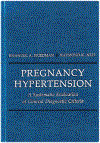Preeclampsia and eclampsia: the conceptual evolution of a syndrome
- PMID: 35177220
- PMCID: PMC8941666
- DOI: 10.1016/j.ajog.2021.12.001
Preeclampsia and eclampsia: the conceptual evolution of a syndrome
Abstract
Preeclampsia, one of the most enigmatic complications of pregnancy, is considered a pregnancy-specific disorder caused by the placenta and cured only by delivery. This article traces the condition from its origins-once thought to be a disease of the central nervous system, recognized by the occurrence of seizures (ie, eclampsia)-to the present time when preeclampsia is conceptualized primarily as a vascular disorder. We review the epidemiologic data that led to the recommendation to use diastolic hypertension and proteinuria as diagnostic criteria, as their combined presence was associated with an increased risk of fetal death and the birth of small-for-gestational-age neonates. However, preeclampsia is a multisystemic disorder with protean manifestations, and the condition can be present even in the absence of hypertension and proteinuria. Toxins gaining access to the maternal circulation have been proposed to mediate the clinical manifestations-hence, the term "toxemia of pregnancy," which was used for several decades. The search for putative toxins has challenged investigators for more than a century, and a growing body of evidence suggests that products of an ischemic or a stressed placenta are responsible for the vascular changes that characterize this syndrome. The discovery that the placenta can produce antiangiogenic factors, which regulate endothelial cell function and induce intravascular inflammation, has been a major step forward in the understanding of preeclampsia. We view the release of antiangiogenic factors by the placenta as an adaptive response to improve uterine perfusion by modulating endothelial function and maternal cardiovascular performance. However, this homeostatic response can become maladaptive and lead to damage of target organs during pregnancy or the postpartum period. Early-onset preeclampsia has many features in common with atherosclerosis, whereas late-onset preeclampsia seems to result from a mismatch of fetal demands and maternal supply, that is, a metabolic crisis. Preeclampsia, as it is understood today, is essentially vascular dysfunction unmasked or caused by pregnancy. A subset of patients diagnosed with preeclampsia are at greater risk of the subsequent development of hypertension, ischemic heart disease, heart failure, vascular dementia, and end-stage renal disease. However, these adverse events may be the result of a preexisting vascular pathologic process; it is not known if the occurrence of preeclampsia increases the baseline risk. Therefore, the understanding, prediction, prevention, and treatment of preeclampsia are healthcare priorities.
Keywords: Elevated Liver enzymes and Low Platelets (HELLP) syndrome; Hemolysis; acute fatty liver; albuminuria; angiogenic factor; biomarker; blood pressure; cardiovascular disease; chronic hypertension; convulsion; eclampsia; edema; fetal death; genetic predisposition; gestational hypertension; great obstetrical syndromes; history; hypertension; hysterotonin; imitator; ischemia; placental growth factor (PlGF); postpartum preeclampsia; pregnancy-induced hypertension; proteinuria; severe preeclampsia; small for gestational age (SGA); soluble fms-like tyrosine kinase-1 (sFlt-1); stillbirth; toxemia; toxin; uteroplacental ischemia; vascular endothelial growth factor (VEGF).
Copyright © 2021. Published by Elsevier Inc.
Conflict of interest statement
Figures
















References
-
- CHESLEY LC. History and epidemiology of preeclampsia-eclampsia. Clin Obstet Gynecol 1984;27:801–20. - PubMed
-
- CHESLEY LC. A short history of eclampsia. Obstet Gynecol 1974;43:559–602. - PubMed
-
- CHESLEY LC. Hypertensive disorders in pregnancy New York, NY: Appleton-Century-Crofts, 1978:17–34.
-
- FRANÇOIS BOISSIER DE SAUVAGES DE LACROIX. Pathologia methodica: Montpellier, Martel, 1739.
Publication types
MeSH terms
Substances
Grants and funding
LinkOut - more resources
Full Text Sources
Medical
Miscellaneous

